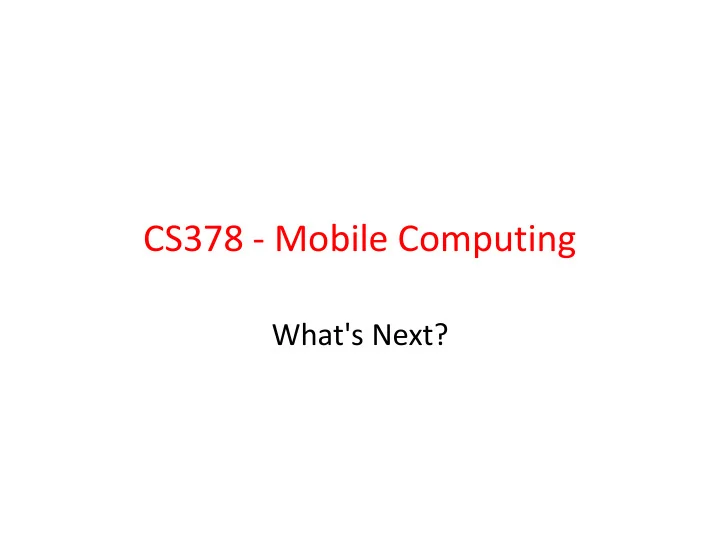

CS378 - Mobile Computing What's Next?
Fragments • Added in Android 3.0, a release aimed at tablets • A fragment is a portion of the UI in an Activity • multiple fragments can be combined into multi-paned UI • fragments can be used in multiple activities 2
Fragments • Part of an activity – directly affected by Activities lifecycle • Fragments can be swapped into and out of activities without stopping the activity • On a handset one with limited screen space, common for app to switch from one activity to another – with a larger screen swap fragments in and out 3
Fragments old new 4
Fragments 5
STATUS BAR NOTIFICATIONS 6
Status Bar Notifications • Status Bar Notifications add an icon to the system's status bar – can add a ticker-text message with icon • and add a message in the notifications window • When user selects the notification Intent created which can start an Activity – can also alert user with sound, vibration, and /or flashing lights on device 7
Status Bar Notifications • Used when background service needs to alert user to an event that requires response – design: background service should never launch an activity on its own 8
Status Bar Notifications • Advice for Notifications – use for time sensitive events – … that involve other people – don't create notifications for events not directed at user – don't create notification for Activity that is active 9
Notifications Window Bad Notifications • Don't create notifications for low level technical details • Don't create notifications for errors that user can't fix or if app can recover on its P own • Don't create notifications for services user can't start and stop 10
COPY AND PASTE 11
Copy and Paste • clipboard based framework • simple and complex data types can be copied and pasted – text strings, complex data structures, text and binary stream data • Simple text stored on clipboard • complex data handled via content providers 12
Copy and Paste • to copy and paste: • data placed in clip object, clip object placed on system-wide clipboard • clip object can be: – text, a simple String – URI for copying complex data from a content provider – Intents to copy application shortcuts • only one clip on clipboard at a time 13
Copy and Paste • An app can support some or all of the data types • Examine data on clipboard and decide if user should have option to paste it – may not make sense to allow pasting of URI / content provider data or Intents 14
WIDGETS 15
Widgets • Referred to as an App Widget • widgets are miniature application views than can be added to other applications – normally the Home Screen View – other "App Widget Hosts" • Widget sent periodic updates • Widgets essentially a BroadcastRecevier with XML layout 16
Widgets • To create App Widget: • Create a AppWidgetProviderInfo • object that contains metadata for the App Widget, layout, update frequency – normally defined in XML • Implement AppWidgetProvider class that defines basic methods to update Widget • create layout: not all layouts and UI widgets supported 17
WI-FI DIRECT 18
Wi-Fi Direct • Added in ICS, Android 4.0 API level 14 • allows devices with appropriate hardware to connect directly via Wi-Fi with no intermediate access point • discover and connect to other devices • much larger range than Bluetooth • Useful for applications that share data among users – multi player game, photo sharing 19
Wi-Fi Direct • WifiP2pManager class provides methods to discover, request, and connect to peers • Various Listeners that provide information on success or failure of method calls from WifiP2pManager • Intents notify application of events detected by Wi-Fi direct framework such as newly discovered peer – implement broadcast receiver for intents from Android system about Wifi Direct 20
GESTURES 21
Gestures • Standard gestures handled via the GestureDetector class – touch event – double tap – long press – fling – scroll 22
Complex Gestures • Non standard gestures required lots of code to rezognize • Android 1.6 introduced new APIs to store, load, draw, and recognize gestures • Gesture Builder app on emulator – emulator must include virtual SD card – allows creating set of gestures for your ppliaction 23
Complex Gestures • Each gesture associated with name • multiple gestures can have same name – variations on same gesture, better chance of recognizing • Move gestures from emulator to application res/raw folder 24
Complex Gestures • Recognizing gestures via a GestureOverlayView • simple drawing board on top of view that shows and records user gestures • When gesture complete GestureLibrary queried to see if gesture is recognized • Predictions between entered gesture and those in the library 25
And Still More! • Bluetooth • Near Field Communication • Live Wallpapers • Remote Storage • USB devices (recall radar detector, heart rate monitors) • Audio Capture, Speech Recognition 26
Recommend
More recommend